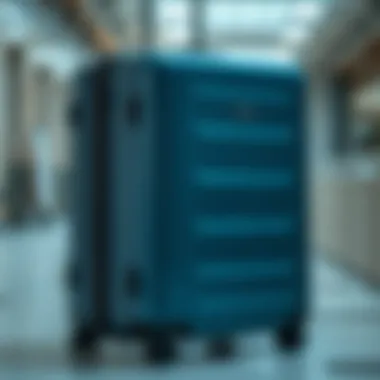The Evolution and Significance of Waterproof Luggage


Intro
The journey of waterproof hard luggage has been nothing short of fascinating, weaving together threads of technology, practicality, and fashion. Today, with the rise of global travel, the subtle yet pivotal role hard luggage plays becomes perfectly clear. As frequent flyers, adventurers, and weekend wanderers turn their eyes to water-resistant travel solutions, understanding these innovations takes precedence.
In the travel sector, waterproof hard luggage is more than just an accessory; it is a reliable ally that protects valuable belongings against the rigors of various climates and environments. Aspects like durability, weight, and style also come into play when selecting the ideal travel companion. This exploration looks into how these pieces have developed over time, the materials that have made strides in technology, and essential maintenance tips for longevity—catering seamlessly to the needs of the modern traveler.
Through discussion of the historical evolution and modern utilities of these versatile storage solutions, readers can expect clarity about which options stand out among the fray of choices. So, if you're someone who finds joy in experiencing different cultures or scaling mountains in far-off lands, this article is your go-to guide for what constitutes exceptional waterproof luggage in today’s market.
Stay tuned as we navigate through the currents of design trends, consumer preferences, and the intricate details that make waterproof hard luggage a must-have for the discerning traveler.
Historical Perspective of Luggage Innovation
The history and evolution of luggage present a fascinating look into how our travel needs and technologies have transformed over the centuries. Luggage isn’t just about carrying clothes and personal items; its design and functionality have a direct relationship with transportation methods, societal norms, and environmental concerns. In understanding the historical context of luggage innovation, we can appreciate the strides taken in creating highly functional and reliable designs, notably in waterproof hard luggage, which now serves discerning travelers across the globe.
Origins of Hard Luggage
Hard luggage originated in the 19th century when travelers required more durable solutions than cloth trunks or leather bags. Adventurers, merchants, and aristocrats all needed to transport their belongings safely during long, uncertain journeys. Early hard luggage often featured wooden frames and leather coverings, providing enough sturdiness to withstand rough handling. Some were even adorned with intricate designs, reflecting the status of their owners.
Early innovations laid groundwork for sturdy luggage types that would evolve more rapidly in the 20th century with the invention of materials like aluminum and fiberglass. These materials not only improved durability but also significantly reduced weight, making travel more convenient. In many ways, the advent of hard luggage mirrored broader technological shifts seen during the industrial revolution—prioritizing convenience and reliability in a world where travel expanded with railways and later, automobiles.
The Shift to Waterproof Materials
As travel became more popular, the need for better protection against the elements became apparent. The shift to waterproof materials marked a pivotal moment in luggage development, with manufacturers realizing that safeguarding belongings from water damage was essential for travelers. The introduction of waterproof fabrics, such as nylon and polyester, revolutionized the industry. While early hard luggage provided structural integrity, it was the integration of waterproof materials that truly enhanced the functionality of these products.
With advancements in technology, the waterproofing process itself evolved. Sealants and specialized coatings have become standard practice, further enhancing the capability of hard luggage to shield contents regardless of external conditions. By creating bags that could withstand both the torrential rain of a storm and the spray of ocean waves, manufacturers targeted a growing market of people eager to explore new environments without fear of damaging their essentials.
In summary, the journey of luggage from wooden trunks to sophisticated waterproof hard luggage encapsulates innovation driven by necessity. As consumer demands shift, the industry continues to adapt and evolve. Understanding this background is key to navigating today’s luggage options and enhancing travel experiences to meet modern expectations.
Understanding Waterproof Technology
Waterproof technology represents a cornerstone in the development of hard luggage. As travelers increasingly seek robust solutions that shield their belongings from unpredictable weather, the evolution of this technology marks a significant shift in both functionality and design. In this section, we will unpack the essentials behind waterproof fabrics, sealants, and zippers—elements that combine to create luggage which can withstand the elements.
Material Science Behind Waterproof Fabrics
The heart of waterproof technology lies in the material used for creating these hard luggage items. Materials like polycarbonate, ABS plastic, and even some advanced composites have become quite popular.
- Polycarbonate: Known for its resilience, polycarbonate luggage can endure heavy impact while remaining light. Its properties allow for easy molding into sleek designs without compromising on durability.
- ABS plastic: Often used for budget-friendly luggage, ABS offers decent waterproof characteristics and a good balance between cost and durability.
- Advanced composites: These materials, though more expensive, combine the best of both worlds. They provide both lightweight construction and exceptional resistance to water and punctures.
Additionally, laminate treatments can be applied to these fabrics, enhancing their waterproof abilities. For instance, luggage coated with a polyurethane layer ensures that water beads off rather than seeps through. The realm of waterproof materials is ever-changing, and understanding these advancements gives consumers an upper hand when choosing durable luggage.
Sealants and Zippers: Keeping Water Out
Even the best materials can fall short if combined with subpar closures and seals. That's where sealants and zippers enter the fray as unsung heroes in waterproof luggage design.


- Sealants: These are used at crucial seams where two pieces of material come together. Heat-welded seams or specially designed adhesive tapes help prevent leaks. A well-sealed bag will keep its contents dry, regardless of how heavy the rain might be.
- Zippers: Traditional zippers allow for easy access but can be a weak point when it comes to waterproofing. Brands like YKK have developed waterproof zipper technology that uses rubber or silicone linings to block water entry. Some manufacturers even use magnetic closures for a completely watertight solution.
"The interplay between material science and the mechanics of zippers is what differentiates basic luggage from true waterproof hard luggage."
By prioritizing robust sealants and high-quality zippers, brands can ensure that every inch of the luggage is effectively protected against the elements. These aspects not only enhance the durability of the luggage but also reassure consumers that their valuables are safe, no matter the journey.
Design Principles of Waterproof Hard Luggage
When it comes to waterproof hard luggage, the design principles play a pivotal role in determining both functionality and user experience. As travelers become increasingly discerning, luggage designs must not only protect belongings but also cater to the demands of modern travel. This section delves into the key design principles that make waterproof hard luggage not just a protective case, but a travel companion worthy of investment.
Ergonomics and User-Friendly Features
Ergonomics is more than a trendy term tossed around in product design; it's a necessity in luggage creation. The right ergonomic features can transform a cumbersome travel experience into a smooth journey.
One effective design element is the incorporation of comfortable handles and adjustable straps. When you think about lugging heavy bags through an airport, having handles that contour to the hand makes all the difference. It’s these small touches that enhance the overall user experience. Also, some brands are now adopting anti-rolling wheels that provide smooth maneuverability, removing the hassle of dragging the bag behind you.
Another significant aspect is the weight distribution within the luggage. A well-designed bag balances its contents, preventing any undue strain on the body. For instance, compartments are strategically placed to ensure heavier items are stored closest to the wheels, preserving the luggage's center of gravity. This design consideration makes for a much easier transport, especially when in crowded spaces like terminals or train stations.
Additionally, user-friendly features such as built-in USB ports to charge devices or RFID-blocking pockets for securing passports and credit cards have become sought after. These thoughtful integrations reflect the needs of today’s traveler — one who balances style with practicality.
Aesthetic Appeal in Functional Design
While functionality is critical, the aesthetic appeal of waterproof hard luggage cannot be discounted. As the industry evolves, brands are recognizing that travel accessories are also fashion statements. Luggage must embody a blend of style and utility.
The trend of custom designs and unique color palettes reflects this sentiment. Brands like Away or Samsonite not only focus on durable materials but also offer customizable pieces to suit individual tastes. Sleek lines, bold colors, and even prints can convey a traveler’s personality, making their luggage feel more like an extension of themselves rather than just a storage box.
Furthermore, materials play a key role in both aesthetics and function. Advances in technology have given rise to innovative materials, such as polycarbonate, which is not just durable but can also be molded into stylish shapes. A well-designed shell can exhibit class while offering unrivaled protection against the elements.
Top Brands in Waterproof Hard Luggage
The landscape of waterproof hard luggage has seen remarkable transformations, not only in innovation but notably through distinguished brands that have set the standard. These top brands play a critical role in shaping consumer expectations and driving advancements within the industry. Known for their commitment to quality, resilience, and aesthetic appeal, they present a myriad of options suited to the diverse needs of travelers today.
Market Leaders and Their Offerings
Leading the charge in the realm of waterproof hard luggage are brands like Samsonite, Rimowa, and The North Face. Each of these manufacturers brings a unique flavor to the market, combining functionality with cutting-edge design.
- Samsonite: This name is synonymous with travel. Their waterproof hard luggage often boasts features such as dual wheels for an effortless glide, accompanied by a sleek contemporary look. The Proxis series, for example, is made from a revolutionary material that not only withstands water but also absorbs shocks, ensuring your belongings remain unscathed.
- Rimowa: Known for their distinctive aluminum cases, Rimowa recently ventured into using polycarbonate materials. Their Essential collection emphasizes lightweight durability and water resistance, ensuring that modern travelers can navigate through rain-soaked airport terminals without worry.
- The North Face: Outside of the traditional luggage realm, The North Face adapts outdoor utility to functional hard luggage. With rugged designs, their luggage is crafted to conquer the elements while providing ample storage. For instance, their Rolling Thunder duffle blends the comfort of a soft bag with hardiness suitable for tough environments.
This mix of brands demonstrates an evolving approach in the luggage industry. Their offerings often emphasize user experience, leading to innovations that respond directly to traveler feedback. With such a variety of styles and functionalities, each brand creates a competitive environment that drives ongoing improvements.
Emerging Brands Challenging the Status Quo
While established names command respect, several emerging brands are shaking things up, introducing fresh perspectives in waterproof hard luggage.
- Away: This relatively new brand has gained a loyal following thanks to its sleek design and direct-to-consumer model. The Bigger Carry-On is a gem, packed with practicality, including a built-in USB charger, yet still manages to be waterproof thanks to its premium polycarbonate exterior.
- Parker Clay: Focusing on ethical manufacturing, Parker Clay has started to gain traction. Their design marries classic styles with waterproof capabilities, offering consumers a conscious option in luxury travel. Their Weekender bags are not only stylish but also avoid water damage, appealing to the environmentally-minded traveler.
- Tumi: Although more established, Tumi continually innovates to challenge existing paradigms. Their Alpha 3 series integrates weather-resistant materials combined with best-in-class organization features. It’s functional yet sophisticated, appealing to business travelers with high-end tastes.


The innovation from both established and emerging brands signifies a rigorous dedication to improvement. As travelers evolve in their preferences, these brands must adapt to stay relevant, promising an exciting future for waterproof hard luggage.
"In a world where change is the only constant, the luggage industry is no exception; brands must innovate or risk falling behind."
It's clear that the top brands in waterproof hard luggage are not merely about carrying belongings; they represent a commitment to durability, style, and the ever-evolving needs of the modern traveler. Whether through technology, sustainable practices, or innovative design, these brands are dedicated to crafting solutions that reflect today's fast-paced, unpredictable travel landscape.
For further insights on luggage design and history, you can explore resources like Wikipedia or delve into materials science at britannica.com.
Consumer Preferences and Trends
Understanding consumer preferences and trends is essential in today's fast-paced market, especially when talking about waterproof hard luggage. As the travel landscape evolves, customers are looking for more than just durability; they want functionality, style, and sustainability in their luggage choices. This section delves into how these preferences shape the industry and what it means for brands and consumers alike.
Identifying Key Consumer Demographics
To effectively cater to customers, brands need to pinpoint who their buyers are. The demographics of waterproof hard luggage consumers can be quite varied but often include:
- Frequent Travellers: Business professionals and jet-setters who prioritize reliability and performance in luggage.
- Outdoor Enthusiasts: Adventurers who require tough, durable options that can withstand the elements.
- Fashion-Conscious Individuals: Shoppers who want their luggage to reflect their personal style, blending function with aesthetic appeal.
- Eco-Conscious Buyers: Customers who prioritize sustainability and are often willing to pay a bit more for eco-friendly options.
Each group has its own unique set of priorities and preferences, influencing purchasing decisions. By understanding these demographics, manufacturers can tailor their products to better meet the needs of their target market.
The Influence of Social Media on Buying Choices
Social media plays an undeniable role in shaping consumer behavior, particularly as it relates to product choices. Platforms like Instagram and Facebook often serve as playgrounds where brands can showcase their latest offerings, catching the eye of potential buyers. Here’s how social media is steering the buying choices of luggage:
- Influencers and Reviews: Today's consumers often trust recommendations from influencers more than traditional advertisements. They rely on real-life experiences shared on social media to guide their choices.
- Visual Appeal: Brands utilize striking visuals to enhance their products' attractiveness. A well-crafted post showing off a stylish piece of luggage in a beautiful setting can significantly affect a purchase decision.
- Community Engagement: Social media fosters a sense of community among travel enthusiasts who share their tips and experiences with waterproof luggage. This interaction can boost brand loyalty as customers feel connected to others with shared interests.
"In the digital age, the voice of the consumer is louder than ever. Brands must listen to their audience to remain relevant."
As marketers focus on strategies that engage consumers in authentic ways, a shift in buying patterns emerges. It’s crucial for brands to stay attuned to the latest trends circulating on social media to keep pace with customer expectations.
Sustainability Considerations in Luggage Manufacturing
In recent years, the focus on sustainability has permeated various industries, and luggage manufacturing is no exception. As environmentally conscious consumers grow in number, brands must adapt to this shift in mindset. This section aims to highlight the importance of sustainability within the realm of waterproof hard luggage, exploring ethical sourcing of materials and recycling's role in design. These elements are not only beneficial for the environment but also resonate deeply with consumers who prioritize eco-friendly practices.
Ethical Sourcing of Materials
Luggage manufacturers are increasingly aware of the materials they choose to use. Ethical sourcing refers to acquiring materials in a way that considers the environmental and social impact. This could mean using biodegradable plastics, organic cotton, or even alternative materials such as sustainable bamboo.
One prominent benefit of ethical sourcing is the positive message it sends to consumers. When a brand commits to using sourced materials, it builds a reputation that enhances customer loyalty. Take a company like Marmot, which emphasizes using recycled materials wherever possible. By opting for these environmentally friendly options, they not only lessen their ecological footprint but also provide customers with a product they can feel good about using.
"Ethical sourcing is not just a trend; it’s becoming a necessary standard in manufacturing."
Furthermore, transparent supply chains allow consumers to trace the origin of materials. This transparency is a solid pillar in the realm of sustainability, as it showcases how genuine a brand's effort is toward eco-friendliness. Customers today are equipped with the knowledge to differentiate between marketing fluff and authentic practices, making ethical sourcing a critical aspect of luggage manufacturing.


The Role of Recycling in Hard Luggage Design
The recycling of materials in luggage design is not solely a practice; it’s rapidly turning into a necessity. Innovative brands are tapping into the potential for repurposing plastic and other materials. Brands like Tortuga design their travel bags with recycled materials, proving it is possible to create functional, stylish, and environmentally friendly luggage.
Recycling offers several advantages in the manufacturing process. First, it cuts down on waste, tackling the issue of landfill overflow. Second, it minimizes the need for virgin materials which require extraction and processing, proven to be resource-intensive.
Here are some recycling processes being adopted in hard luggage design:
- Post-consumer recycling: Using collected consumer waste, such as recycled PET, to create new luggage.
- Upcycling: Transforming surplus materials into stylish accessories or components for bags.
- Closed-loop recycling: Creating products that can be reused at the end of their life cycle to form new products.
By integrating these recycling practices, companies are addressing both environmental and market demands. As consumer expectations shift toward sustainability, luggage brands that prioritize recycling not only carve a niche but also lead the charge toward an eco-friendlier future in corporate practices.
Sustainability in luggage manufacturing represents a convergence of consumer expectations and responsible practices. It influences buyer decision-making, encourages ethical production, and ultimately contributes to the well-being of our planet.
Practical Maintenance of Waterproof Luggage
Maintaining the integrity of waterproof hard luggage is more than just a chore; it's essential for ensuring longevity and functionality. Just like a well-oiled machine, proper maintenance keeps you from running into problems down the road, especially when you frequently travel. Water-resistant material may keep your belongings dry in the rain, but neglecting basic care can lead to deterioration and costly repairs. The right approach to maintenance not only preserves the aesthetics of your luggage but also contributes to a seamless travel experience.
Cleaning Tips for Longevity
Keeping your luggage clean is crucial, and it is often simpler than it sounds. Here are some practical tips:
- Use a damp cloth: Rather than dragging out a bucket of soapy water, a simple damp cloth can do wonders. Wipe down the exterior of your luggage after each trip, especially after exposures to sand, dirt, or those unexpected coffee spills.
- Mild detergent: If there's a stubborn stain on the surface, a mix of warm water with a mild detergent can work magic. Avoid harsh chemicals, as they can damage the waterproof coating.
- Dry it well: Once you've wiped it down, ensure your luggage is completely dry before storing it. Leaving it damp can lead to mold growth, particularly in humid environments.
Making cleaning a part of your routine will pay off in increased life for your luggage and fewer surprises during your travels.
Repairing Minor Damages
No matter how well you care for your luggage, minor damages can occur. Here’s how to tackle them before they escalate:
- Inspect Regularly: Take a moment before and after each trip to check for scratches or nicks. Early detection makes repairs much easier.
- Sealant for Small Tears: For minor cracks or tears, a waterproof adhesive sealant can be a lifesaver. Just like mending a favorite jacket, a quick application can ensure your luggage stays watertight.
- Tighten Loose Zippers: If a zipper is starting to act up, it can be as annoying as trying to zip up a pair of favorite jeans after a few too many dinners. Consider using a zipper lubricant to smooth out the operation.
- Professional Repair: If damage seems extensive or the structure is compromised, don’t hesitate to seek help from professionals. Many luggage brands offer repair services that can restore your investment to its original state.
"A stitch in time saves nine." Taking these minor repairs into your own hands can go a long way in prolonging the life of your luggage and making sure it serves you well in all your journeys.
By adhering to diligent maintenance practices, you’ll find your waterproof hard luggage not only stands the test of time but also enhances your travel experience, ensuring you arrive at your destinations equipped for whatever life throws at you.
The Future of Waterproof Hard Luggage
As the landscape of travel evolves, so does the luggage accompanying modern explorers, notably within waterproof hard luggage. This category is increasingly vital for the discerning traveler, given that the expectations of durability and style are at an all-time high. Ensuring protection against the elements while maintaining an aesthetic appeal is where innovation is prioritized. The future beckons with promise for travelers aiming to safeguard their belongings while navigating varied environments, from bustling cities to serene waterfronts.
Innovative Technologies on the Horizon
The future of waterproof hard luggage is likely to see significant technological advancements. These innovations will play a crucial role in enhancing functionality and user experience. For instance, brands are exploring advanced materials like lighter but equally resilient composites. The integration of smart technology into luggage design is another area of exciting development. Imagine a suitcase that can notify you if it's been opened without your permission or a GPS tracker embedded within, giving peace of mind during hectic travels.
Additionally, techniques to develop self-cleaning fabrics are being tested. These fabrics could repel water while also keeping the exterior clean and pristine longer. If a traveler finds themselves caught in the rain, they might return to their hotel room without a worry about muddy water marks or stains. Brands that embrace these technological enhancements not only solidify their market position but also cater to an audience that values not just functionality but convenience and peace of mind.
Changing Consumer Expectations and Market Evolutions
Consumer expectations regarding waterproof hard luggage are shifting quickly, influenced by a generation that values personalization and environmentally conscious choices. Today’s consumers look for products that reflect their lifestyle, which poses a challenge and an opportunity for manufacturers. There’s a growing demand for versatile bags that can transition seamlessly from a business trip to a weekend getaway, thus blending practicality with style.
Moreover, eco-awareness is driving brand loyalty. Buyers are more inclined to support companies that are transparent about their sourcing and production practices, especially when it comes to the materials used in luggage. Companies that implement sustainable practices, such as using recycled materials or reducing carbon footprints during production, will likely find a dedicated customer base.







